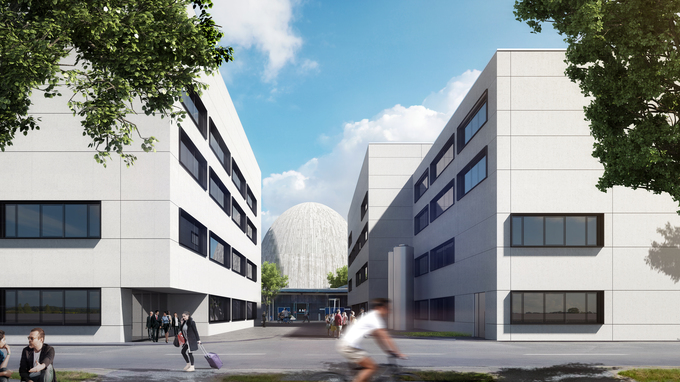Neue Gebäude für das Heinz Maier-Leibnitz Zentrum
60 Jahre nach dem „Atom-Ei“: weitere Neubauten für die Neutronenforschung in Garching
2017-02-20 – Nachrichten aus dem Physik-Department

Die Zahl der wissenschaftlichen Instrumente an der Garchinger Forschungs-Neutronenquelle wuchs in den letzten Jahren von anfänglich 15 auf aktuell 27 an, weitere sechs sind im Bau. Die Erweiterung der Instrumentierung verlangt auch zusätzliche fachkundige Operateure.
Inzwischen arbeiten über 400 Menschen am FRM II und am Heinz Maier-Leibnitz Zentrum (MLZ), unter dessen organisatorischem Dach die wissenschaftliche Arbeit der Neutronenforscher der TUM, des Forschungszentrums Jülich und des Helmholtz-Zentrums Geesthacht zusammengefasst ist. Hinzu kommen jährlich rund 1000 Gastwissenschaftler, die ebenfalls Experimentier- und Büroflächen benötigen.
Eine signifikante Verbesserung der räumlichen Bedingungen sollen ab 2019 zwei neue Gebäude bringen, die nun neben dem „Atom-Ei“ entstehen. Das Architekturbüro HENN konzipierte dazu zwei sich gegenüberstehende vierstöckige Gebäude, die den Blick auf das denkmalgeschützte „Atom-Ei“ aus dem Jahre 1957 einrahmen.
Das nördliche Gebäude entsteht im Auftrag der bayerischen Staatsregierung für die TU München. Auf rund 2000 Quadratmeter Nutzfläche wird es eine zweistöckige Werkstatthalle sowie Büros aufnehmen. Das südliche Gebäude entsteht im Auftrag des Bundesforschungsministeriums. Es wird 2550 Quadratmeter Büro- und Laborflächen für Wissenschaftler des Jülich Centre for Neutron Science (JCNS) und des Helmholtz-Zentrums Geesthacht bieten. Die Baukosten sind auf insgesamt rund 32 Millionen Euro veranschlagt.
Investition in die Zukunft
„Seit genau 60 Jahren gewährt uns das ‚Licht der Neutronen’ in Garching einzigartige Einblicke in das Innere verschiedenster Materialien und wichtiger biologischer Bausteine. Der heutige FRM II ist die leistungsfähigste Neutronenquelle der Welt, und die hier gewonnenen Erkenntnisse sind die Basis für die Entwicklung neuer Technologien, die das Leben der Menschen nachhaltig verbessern“, sagte Prof. Wolfgang A. Herrmann, Präsident der Technischen Universität München. „Die Investitionen von Bund und Land in die räumliche Infrastruktur wird dank des unübertroffenen Leistungsspektrums unserer Neutronenquelle reichlich Früchte tragen.“
„Die von der TU München betriebene Forschungs-Neutronenquelle hat weltweit einen herausragenden Ruf“, sagte Stefan Müller, Parlamentarischer Staatssekretär bei der Bundesministerin für Bildung und Forschung. „Eine wesentliche forschungspolitische Frage ist, wie es uns gelingt, die besten Köpfe für die Forschung zu gewinnen. Dafür brauchen wir optimale Rahmenbedingungen, ein kreatives Umfeld aber auch Infrastrukturen, also Geräte und moderne Gebäude, wie sie hier in Garching entstehen. Diese sind eine wichtige Grundlage, um die Attraktivität des Wissenschaftsstandortes Deutschland noch weiter zu steigern.“
„Der heutige Spatenstich zu den neuen Gebäuden des Heinz Maier-Leibnitz Zentrums ist ein unübersehbares Signal für Spitzenforschung mit Neutronen in Deutschland und Europa“, sagte Bayerns Wissenschaftsminister Dr. Ludwig Spaenle. Die Neutronenforschung hier in Garching steht im Dienst der Bewältigung großer Herausforderungen von Gesellschaft und Wirtschaft etwa im Zusammenhang mit der Energiewende, der Digitalisierung und der Gesundheit. Das MLZ nimmt eine Vorreiterrolle bei der Zusammenarbeit von Wissenschaftlerinnen und Wissenschaftlern aus Universitäten und außeruniversitären Forschungseinrichtungen ein. Wir wollen die Zusammenarbeit in der Forschung über die Grenzen der Einrichtungen hinaus weiter stärken, um bei wissenschaftlichen Problemstellungen die besten Köpfe zusammenzuspannen.“
„Die neuen Gebäude stärken die Zusammenarbeit der universitären und außeruniversitären Forschung. Es entsteht ein neues Glied in der Kette der strategischen Zusammenarbeit zwischen der TU München und dem Forschungszentrum Jülich“, sagte Prof. Sebastian M. Schmidt, Vorstandsmitglied des Forschungszentrums Jülich. „Hier werden in naher Zukunft die Ausbildung junger Wissenschaftler, die Nutzer und Experten der Neutronenforschung unter einem Dach zusammenkommen. Allen Seiten wird dies neue Ideen und Impulse bringen, auf die ich mich jetzt schon freue.“
Mit den neuen Wissenschaftsgebäuden des Heinz Maier-Leibnitz Zentrums kommt zusammen, was zusammen gehört: Menschen zu Menschen, zu Labors und Werkstätten,“ sagte Prof. Thomas Brückel, Direktor am JCNS und Sprecher des MLZ-Direktoriums. „Beim gemeinsamen Kaffee werden neue Ideen und Zusammenarbeiten geboren werden, über die Grenzen der institutionellen Zugehörigkeit hinweg. Die neuen Labors werden das mächtige Werkzeug der Forschung mit Neutronen ergänzen und der Wissenschaft am MLZ weitergehende Einblicke ermöglichen.“
- Redaktion
- Dr. Andreas Battenberg, Dr. Johannes Wiedersich